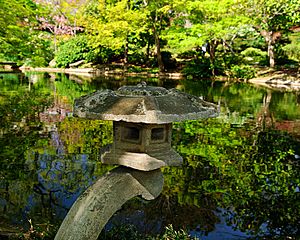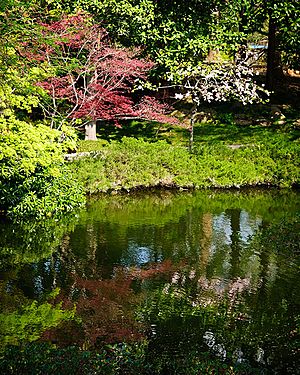Fort Worth Japanese Garden facts for kids
The Fort Worth Japanese Garden is a beautiful 7.5-acre Japanese Garden located within the Fort Worth Botanic Garden. It was built in 1973. Many of the plants and building materials were given as gifts by Fort Worth's sister city, Nagaoka, in Japan.
Visitors to the garden can enjoy many cool features. These include a peaceful zen garden, a special deck for moon viewing (called tsukimi), lovely waterfalls, and pretty cherry and Japanese maple trees. There's also a traditional pagoda and places to buy food to feed the hundreds of koi fish swimming in the garden's three ponds. The garden hosts two fun events each year: the Spring Festival and the Fall Festival. These events show off Japanese art and culture.
Contents
Building the Garden: A Special Gift
The Fort Worth Japanese Garden was created with help from many people and groups. They donated materials from all over North Texas and other parts of the USA. In the 1990s, Nagaoka, Fort Worth's sister city in Japan, sent a very special gift: an authentic Mikoshi. This is a sacred, decorated palanquin (a kind of covered chair carried on poles). You can see it inside the garden today.
Nagaoka also donated several trees, including beautiful pines and flowering cherry trees. In 1997, Mr. Shigeichi Suzuki, a landscape architect from Nagaoka, gave the garden plans for a new karesansui-style area. This new section was finished in 2000 and is now called the 'Suzuki Garden'.
From Valley to Garden
The Fort Worth Japanese Garden was built in a small valley. This area was once a rough, uneven piece of land that led down to the Trinity River. Over time, it was used for different things, like a gravel quarry where stones were dug up. Today, this quiet valley has become a peaceful Japanese-style 'stroll garden'. This type of garden is designed for visitors to walk through and enjoy changing views.
At the center of the garden are several ponds. These ponds are surrounded by small hills, and a network of paths, pavilions (small buildings), bridges, and decks connects everything. As you walk along these paths, the garden slowly reveals new and beautiful scenes, making your stroll a unique experience.
Garden Styles and Special Features
The Fort Worth Japanese Garden is designed in the style of Edo-period (1600-1868) stroll gardens from Japan. It brings together several different Japanese garden styles into one place. For example, you can see elements of:
- 'Hill-and-Pond' gardens, which feature hills and water.
- 'Dry Landscape' gardens, which use rocks and gravel to represent water.
- 'Tea Gardens', which are simple and quiet spaces.
- 'Enclosed Gardens', which are small, private areas.
The garden also includes building styles often found in Japanese gardens. These include designs inspired by Buddhist temples, royal palaces, homes of samurai lords, and houses of rich merchants.
Unique Architectural Elements
The Fort Worth Japanese Garden has some unusual architectural features that make it special. One is called the 'Pavilion'. It looks a bit like the main hall of a Shinto shrine, which is a Japanese place of worship. It stands on posts above the ground and has several sloped roofs with criss-crossed extensions.
Another unique item is the 'Mikoshi', the ornate palanquin given by the people of Nagaoka, Japan. You can also find a 'taijitu' (a yin-yang symbol), a graceful Buddha statue from Southeast Asia, and three stone monkeys (Mizaru, Kikazaru, and Iwazaru). These are all special additions that make the Fort Worth Japanese Garden truly one-of-a-kind.
The Karesansui Garden
The 'Karesansui Garden', once called the 'Meditation Garden', is designed like the famous 'Garden of the Abbot's Quarters' at the Ryoanji temple in Kyoto, Japan. It's a classic 'Flat Garden' with fifteen stones.
What makes this garden unique? It has a raised viewing area that goes all around the flat garden, like a Japanese roofed bridge. This lets you see the garden from every side. Also, there are no plants in the main part of this exhibit. The fifteen large rocks are surrounded by patterned gravel, held in place by a stone border, and then by black volcanic rock. The only plants you'll see here are tiny lichens growing on the rocks. This simple design is a beautiful example of the calm and minimalist Zen style.
The Moon-Viewing Deck
The Fort Worth Japanese Garden's 'Moon-Viewing Deck' is a creative take on the famous 'Kogetsudai' sand cone at the Ginkakuji temple. Fort Worth's version is designed for visitors to interact with. You can walk up the steps to the flat top of the cone and look down at the garden.
At the very top, there's a 'Taijitu' (a yin-yang symbol) pressed into the concrete. This unusual but fun addition to a Japanese garden is a symbol of Chinese origin. It also has ties to Korean culture and is seen as a symbol of Eastern mystery in American pop culture. The exhibit also has an amphitheater built into the same platform as the cone. Together, they are used for performances during the garden's two annual festivals and as a lovely outdoor chapel for weddings under the moonlight.
Dry River Landscapes
The Fort Worth Japanese Garden has two karesansui (dry landscape) exhibits that look like rivers flowing from mountains. One of them starts near the garden's 'Pavilion'. It 'flows' down a winding channel lined with boulders, leading to what looks like a small lake or sea. Here, the 'water' is made entirely of decorative gravel, and you can view it from different levels along its path.
The other dry river exhibit is near the garden's 'Moon-Viewing' deck. Like the first, it begins with a group of boulders that represent a rugged mountain range. This 'river' of mixed stones then goes down a terraced, boulder-lined channel. This channel is surrounded by a soft, grassy mound. The 'river' then disappears among several large boulders, just like a river might vanish into a canyon. This creative design is meant to represent a famous American landmark: the Colorado River. It starts in the Rocky Mountains, flows across a high plateau, and then descends into the deep Grand Canyon.



